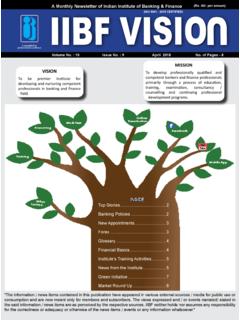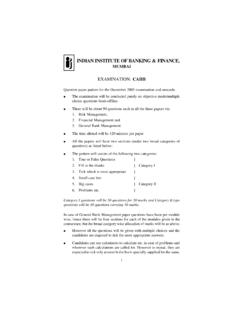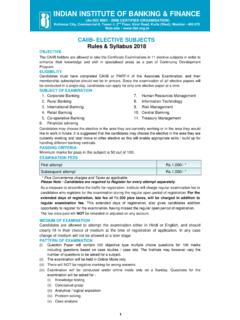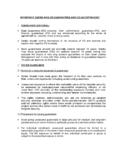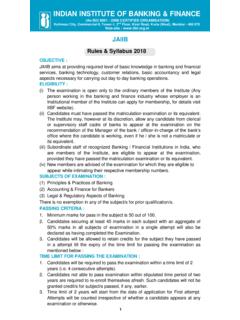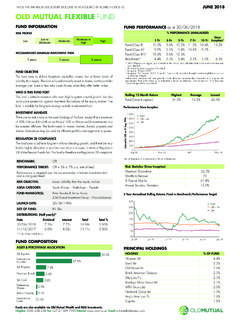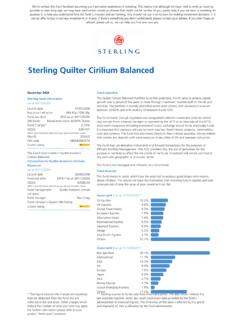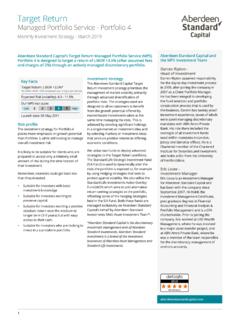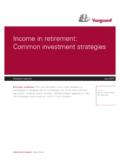Transcription of MUTUAL FUNDS AND BANKING: INDIA AND …
1 MUTUAL FUNDS AND banking : INDIAAND global EXPERIENCEbyDr N. SubrahmanyamProfessor of Finance, IBS, Hyderabad 2008 09 EXECUTIVE SUMMARYEven though the first MUTUAL fund in the country is more than40 yrs old, the MUTUAL fund industry is still nascent one. Mostof the MUTUAL FUNDS are about 10 years old. As percentages ofthe savings of the household sector; they manage only about3%. This shows, however, a great potential that the industryhas. This slow growth by the MUTUAL FUNDS is a surprisingone when one collects that, just over a decade back, theindustry in one year, was managing as high as 8-9% offinancial savings of the household sector. Also during thelast 15 years, interest rates on safe banking instruments havebeen coming down.
2 The number of MUTUAL FUNDS has grownbut their penetration in household sector has not increasedcommensurately. This calls for an explanation on furtherresearch. Unfortunately the area of MUTUAL FUNDS has been ahighly under researched one. The relative yields of long terminstruments, their riskiness, comparative performance etc areareas of research where not enough attention has been paidby the researchers. The reason may be that industry is anascent one and a decade is not sufficiently long period fordrawing meaningful conclusions. The period chosen for thisstudy is when public MUTUAL FUNDS have already been set upand private sector FUNDS entered and global MUTUAL FUNDS arejust entering.
3 The external environments are common to public sector MUTUAL FUNDS have the legacy andperformance and advantage of distribution network, but nowthey are facing the adverse market situation. The private sectormutual FUNDS entered perhaps at a wrong time but have afreedom to recruit talent at the market price and started withthe best available talent in the financial sector. This set upallowed good competitive environments for fund is a good reason to deviate from the long term study ofother countries because the returns on the equity investmentoutperforms returns on the risk free instruments. Only a goodresearch can help us to know whether this is also anappropriate time for fund industry is an important financial intermediarythat strives to meet the twin objectives of mobilizing thesavings from the surplus pool and generate expected rates ofreturns through participation in industrial growth of theeconomy.
4 The growth on success of MUTUAL fund industrydepends upon sound financial management policies and theinvestment practices it pursues to bring about the valueaddition to the financial assets it manages. The subjectassumes greater significance in view of present turbulentmarket environment as well as the economic scenario ofliberalization, globalization leading to a more intensecompetitive environment. Of late, Indian MUTUAL FUNDS haveattracted every investor s attention and have become one ofthe best options for retail investors primarily because MF onthe one hand diversifies the portfolio by investing in variousasset classes and minimizes the risk, and at the other handmaximizes the opportunities and is affordable by all.
5 MFprovides liquidity as well as tax benefits to the investors. Theinvestor gets regular information on the value of hisinvestments and in that way the transparency is , MUTUAL FUNDS are subject to several regulationsthat protect investor confidence and above all they areprofessionally fund companies in INDIA are influencing the retailinvestors to invest their surplus FUNDS with or withoutcomplete understanding to the MUTUAL FUNDS . It also exploresthe factors influencing the retail investor to invest in mutualfund schemes. It also seeks to understand the role of SEBI insafeguarding the interest of retail investor in MUTUAL FUNDS . Italso identifies the key factor that influences the customerpreference for a particular MUTUAL fund .
6 One of the objectivesof the present study was to evaluate the financial performanceof various MUTUAL fund schemes on different of MUTUAL fund schemes has been evaluated byusing risk to standard deviation, sharp ratio Treynor the study it was found that, the majority of sample fundshave experienced high returns and lower variability on thereturns as compared to market portfolios. Earlier, every mutualfund offering resembled the other and this was one reasonwhy the investors were a bit slow in embracing the mutualfund option. Now the time has changed and fund houses havecome out with a host of new products that eye investor swallet. Indian MUTUAL fund industry has been growing at ahealthy pace of for the past 8 years and the trend willmove further.
7 The size of MUTUAL fund industry is expected tobe worth 4 lakh crores by 2010 from its current level of over2 lakh crores and in future investors would prefer mutualfunds for their investment destination rather than choosingtheir FUNDS from stock market. It also says that MUTUAL fundsshould be one of the major instruments of wealth ,it provides a snapshot of challenges that lie MUTUAL fund industry is among the most successfulrecent financial innovations. Over the past few decades,the MUTUAL fund industry, both in the US and elsewhere, hasexploded. While the US continues to be the largest marketin terms of number of FUNDS and assets under management,investors and researchers are generally unaware that USdomiciled FUNDS accounted for only 15% of the number offunds available globally and 60% of the world s fund are also not aware that the nation which is home tothe second largest fund industry (measured by fund assets)is Luxembourg, with of world MUTUAL fund , France and Korea offer the second largest numberof MUTUAL FUNDS available worldwide (13% of the worldtotal for each country).
8 In aggregate, as of 2005 the globalmutual fund increased to doubling those managed in 1998($ )The growth of the MUTUAL fund industry in the US mutualfund industry has played an extremely important role in theeconomy. This trend has spread to a significant number ofcountries around the world. MUTUAL FUNDS industry controls asizeable stake of corporate equity and plays a fundamentalrole in the determination of the stock prices. As a result,investors are increasingly concerned about fund selection anddemanding detailed MUTUAL fund information and : The horizontal axis shows the fiscal year ending MarchSource: Nomura Institute of Capital Markets Research basedon materials from the Reserve Bank of IndiaFigure 1.
9 Household financial assetsINTRODUCTIONE stablishing a business base in the BR1Cs1 economies hasbecome a key business theme for the world s financialinstitutions, and this has increasingly shined a spotlight onthe future growth potential of INDIA s MUTUAL fund and MUTUAL FUNDS only account for of personalfinancial assets in INDIA , suggesting that INDIA s individualinvestors have a tendency to avoid risk assets (Figure 1). Thiscould also be interpreted, however, as an indication of thehuge potential in INDIA for growth in investments byindividuals into MUTUAL FUNDS and other risk assets. INDIA hasrecently seen a rapid decline in the number of its extremelypoor, along with an increase in its wealthy and middle-incomesegments, with the latter referred to as the new middle class.
10 In INDIA , the owners of MUTUAL FUNDS include not only thewealthy but also regular retail investors, and because of thisgrowth in the middle- class should further broaden the marketof potential MUTUAL fund investors. In this paper, we firstprovide an overview of the assets managed by INDIA s mutualfund industry, both now and in the past, and of the legalframework for MUTUAL FUNDS , and then discuss the currentsituation and recent trends in financial products, saleschannels and asset management portfolios manage an ever-increasing part ofinvestors savings. Although they offer small investors theopportunity to invest in diversified portfolios and frees themto a large extent from the burden to make allocation decisions,it is important to know what cost these alleged advantagesare offered.
